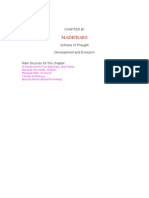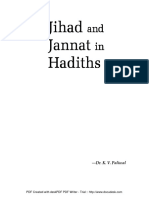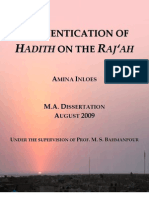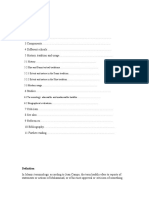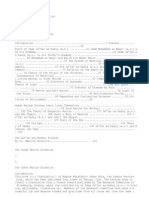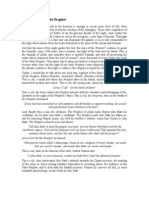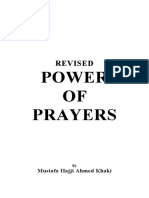Companions Imams
Companions Imams
Uploaded by
kumailrajaniCopyright:
Available Formats
Companions Imams
Companions Imams
Uploaded by
kumailrajaniOriginal Description:
Copyright
Available Formats
Share this document
Did you find this document useful?
Is this content inappropriate?
Copyright:
Available Formats
Companions Imams
Companions Imams
Uploaded by
kumailrajaniCopyright:
Available Formats
Imam as-Sadiq (a)
himself encouraged
his companions to
narrate traditions.
He said:
"We do not consider
a faqih (jurist)
amongst them [the
Shias] to be a faqih
until he is [also] a
narrator [of our
traditions]
T
h
e
R
e
s
o
u
r
c
e
P
a
p
e
r
S
e
r
i
e
s
i
s
d
e
s
i
g
n
e
d
t
o
p
r
o
v
i
d
e
m
a
t
e
r
i
a
l
s
t
o
f
a
c
i
l
i
t
a
t
e
t
h
e
i
m
p
l
e
m
e
n
t
a
t
i
o
n
o
f
t
h
e
c
u
r
r
i
c
u
l
u
m
o
u
t
l
i
n
e
d
i
n
t
h
e
C
u
r
r
i
c
u
l
u
m
D
e
v
e
l
o
p
m
e
n
t
P
r
o
c
e
s
s
(
C
D
P
)
R
e
p
o
r
t
.
By:
Dr. Liyakatali N. Takim
T
a
r
i
k
h
S
e
r
i
e
s
#
1
About the Reso ur ce Paper Series
The Resource Papers are published by IEB-Nasimco
as part of an ongoing effort to empower madrasah
teachers and to facilitate their classroom preparation.
The Resource Papers follow the framework and/or
guidelines formulated in the Curriculum Development
Process: First Steps in the Implementation of The
Target Profile of a Madrasah Graduate.
The intent of a Resource Paper is to address a void in
the available resources on themes that flow out of the
conceptual frameworks for core madrasah courses,
and to present them in a contemporary style and
language that is both informative and stimulating. Such
a paper will not only be a very valuable resource for the
madrasah teachers, but also motivate parents to learn
more about those topics.
You can help and make a difference by undertaking to
write a paper on a topic that resonates with you. IEB
will be glad to help by providing general guidance, and
reviewing, publishing and distributing your paper.
For more details about the Resource Papers, please contact
Dr. Liyakatali Takim: ltakim@du.edu
Sadik Alloo: sadikalloo@aol.com
RESOURCE PAPER SERIES
Published by:
IEB - NASIMCO
Islamic Education Board
of Organization of
North American Shia Ithna-Asheri
Muslim Communities
P.O.BOX 87629, Thornhill,
Ontario. L3T5WO Canada
TELEPHONE: (905) 763-7512
FAX: (905) 763-7509
E-mail: iebna@yahoo.com
http://www.naieb.org
1st Published September 2000
Reprinted August 2002
Companions of the
Imams
By: Dr. Liyakatali N. Takim
The Position of My Ahlul-Bayt Amongst
My Ummah Is Similar To Noah's Ark:
Those Who Embarked I t Were Rescued
And Those Who Rejected I t Perished"
Holy Prophet Muhammad (SAWW)
4
TABLE OF CONTENTS
LINK TO THE TARIKH FRAMEWORK...............5
OBJECTIVES OF THE RESOURCE PAPER.........6
1. Acknowledgement and proclamation of the
Imamate of a succeeding Imam ..............................6
2. Narrating Traditions...........................................8
3. Polemical Discourses .......................................10
4. Literary Works..................................................12
5. Jurists................................................................14
6. Adjudicators in Disputes...................................16
EVALUATION........................................................18
DEDUCTION..........................................................20
SELECTED REFERENCES...................................21
5
COMPANIONS OF THE IMAMS
By Dr. Liyakatali N. Takim
Link to the Tarikh Framework
The goal of human conduct on earth is the establishment
of a just social order. There are many verses in the
Quran exhorting human beings to establish justice on
earth (e.g., 4:125, 5:42). It is due to this that the Quran
states that Prophets came with scales (57:25), a
metaphor for justice. Thus the Prophets and Imams were
sent to establish a model society, based on justice and
equity that others could emulate.
Historically, there were times when, due to political
difficulties coupled with limited means of
communication, the Imams could not disseminate and/or
implement their teachings for this Islamic ideal to be
realized. The companions, also known as rijal, stepped
forward and performed some of these duties under the
authority of the Imams. To the extent possible, the Shia,
in fact, established a community within a community. So
it is that, within this narrow sector of society, moral
uprightness and equity was upheld.
6
Objectives of the Resource Paper
The objectives of the paper are two-fold:
To describe and explain the importance
of the different functions performed by
the companions of the Imams.
To evaluate the short and long-term
effects of the companions role, that is,
their impact on their own communities
and on future generations.
The following were some of the functions
performed by the companions of the Imams.
1. Acknowledgement and proclamation of the
Imamate of a succeeding Imam
Description: An important function of the disciples
reported in our sources was their proclamation of an
Imams true successor after his death. The Imams could
not publicly designate their successors due to the difficult
political circumstances. The significance of this role
becomes more evident when it is remembered that after
Imam al-Sadiq (a), most Imams had to contend with rival
claimants to the Imamate. Kulayni, for example, cites a
report that indicates how two disciples of Imam al-as-
Sadiq (a), al-Jawaliqi and al-Ahwal, were eventually
guided to Imam al-Kazim (a) after his father's death.
Initially, they had questioned Abd Allah, Imam as-
Sadiqs (a) eldest son. Abd Allah had claimed to be the
Imam after his fathers death. When Abd Allah failed to
answer their questions on zakat, they abandoned him.
Similarly, after the wafat of Imam al-Kazim (a), many
7
Shias believed that he was the Mahdi. The rijal led to the
acknowledgement of the Imamate of the Eighth Imam.
Furthermore, Shias living in remote places also faced the
threat of the ghulat (exaggerators) many of whom
advanced exaggerated beliefs in the Imams and
themselves. Thus, Abul-Khattab claimed that Imam as-
Sadiq (a) was god and that he (Abul-Khattab) was the
prophet of god. It was left to the rijal to nullify such false
claims. These ghulat often invented hadith and attributed
them to the Imams.
Analysis: Due to his close proximity to an Imam, a
disciple's acknowledgement of the succeeding Imam was
closely examined by the Shias in their search for the
identity of the correct Imam. The associates of the Imams
were instrumental in the allegiance paid to the Imams. By
their acknowledgement of an Imam, the disciples of the
Imams guided the Shiis to the correct source of authority
and refuted claims made by false contenders. The above
anecdote leads us to understand an important dimension
that connected the Imams and their followers. The ilm of
an Imam was an important criterion in the
acknowledgement of his Imamate for it was this factor
which was seen as the sole basis for legitimising any claim
to the Imamate. The failure of Abd Allah to satisfactorily
answer the questions posed led Shiis like al-Jawaliqi to
Imam al-Kazim (a) who substantiated his claim to
Imamate by displaying his knowledge in fiqh. This also
proves our belief that the Imams had ilm that was
bestowed by Allah (swt). As Imam al-Baqir (a) said:
Travel to the east or west, you will not find true
knowledge except that which is coming from this house
(Ahlul-bayt) only.
8
2. Narrating Traditions
Description: Our rituals and ethical precepts are based
mainly on the Quran and hadith (traditions reported from
the Prophet and Imams). Indeed, it is correct to say that the
teachings of our Imams are transmitted in the form of
hadith. Without the hadith, we could not have known of
the practices (sunna) of the Prophet (s) or the Imams (a).
Our hadith literature is centred mainly on Imams al-Baqir
and as-Sadiq (a). According to al-Mufid, four thousand
reporters narrated hadith from Imam as-Sadiq (a). Najashi
notes that al-Hasan b. Ali al-Washsha had met 900
reporters in the mosque of Kufa, each of whom was
saying, Jafar b. Muhammad has related to me... Imam
as-Sadiq (a) himself encouraged his companions to narrate
traditions. He said:
"We do not consider a faqih (jurist)
amongst them [the Shias] to be a faqih
until he is [also] a narrator [of our
traditions]
The disciples of the Imams heard and recorded traditions
of the Imams in their lifetimes. In fact, they are reported to
have transmitted thousands of traditions from the Imams.
Thus, Muhammad b. Muslim is reported to have heard
over 30,000 traditions from Imam al-Baqir (a) whereas
Jabir al-Jufi had heard over 70,000 from the same Imam.
Many of the books that contained these traditions were lost
when Shii libraries were burnt especially during the time
of Shaykh Tusi in 1055 A.D. However, some of these
traditions were preserved and are reported in their books
by the likes of Kulayni, Shaykh Saduq and Tusi.
Analysis: The significance attached to the role played by
the disciples of the Imams in this sphere can be fully
comprehended only when it is viewed in the wider context
9
of various reports on hadith fabrication. Starting with
Imam Zayn al-Abidin (a) (d. 95/713-4), every Imam had
an adversary who would distort or falsify his traditions.
Mughira Said (d. 119/737), an extremist, is charged with
interpolating Imam al-Baqirs (a) traditions. Similarly,
Abul Khattab is accused of distorting Imam as-Sadiqs (a)
traditions. Yunus b. Abd al-Rahman had apparently
recorded Shia traditions in Kufa. When he returned to
Medina, he presented these to Imam ar-Ridha (a). The
Imam denied that these were uttered by Imams as-Sadiq or
al-Kazim and blamed Abul Khattab and his companions
for fabricating their hadiths. Such reports of fabrication of
traditions increased the importance of the rijal as the
preservers of hadith against falsification. In their roles as
narrators of traditions, the rijal were the protectors of
religion since they preserved traditions that could have
been lost or fabricated by other figures.
The role of the rijal as traditionalists is also to be assessed
within the context of rise of the rival factions for the
Imamate. By reporting traditions, the rijal were not only
informing the Shias of the correct religious practices but
they were also exposing false claimants to the Imamate.
Moreover, by reporting traditions, the correct successor to
the Imam could be identified and the communitys
religious beliefs and practices are standardised.
Furthermore, the threat from the ghulat (mentioned above)
could be neutralised.
The disciples also identified the variant factions with
extremist, peripheral and hence isolated beliefs. The rijal
represented the Shii 'norm' through which the correct
views could be differentiated from those promulgated by
the enemies of the Ahlul-bayt.
10
3. Polemical Discourses
Description: Shia beliefs in the Imamate, knowledge and
isma (infallibility) of the Imams had to be defended for the
Shias were continuously challenged regarding their
beliefs. To justify their theological views, the companions
of the Imams employed theological methods of discussion
(as opposed to restricting themselves to mere narration of
traditions) discussing and justifying questions such as the
creation of the Quran, anthropomorphism (whether God
has bodily parts), the nature and extent of God's ilm, free
will and predestination, the infallibility of the Prophets and
Imams etc.
During the times of the Imams there was a successive line
of prominent Shii theologians who defended Shii beliefs
forming, thereby, a structured chain of theologians. Fadl b.
Shadhan, the companion of the eleventh Imam (a) said:
"I am the successor of those before me. I
met Muhammad b. Abi Umayr and
Safwan b. Yahya and others [besides
them] and I was associated with them for
fifty years. And [as for] Hisham b. al-
Hakam may God have mercy on him, he
died and Yunus b. Abd al-Rahman, may
God have mercy on him, succeeded him.
He refuted our opponents. When Yunus
died, he did not leave a successor apart
from as-Sakkak, and he refuted our
opponents until he, may God have mercy
on him, died and I am their successor".
The tradition indicates the emergence of a structure of
prominent rijal who defended Shii doctrines within the
community. It is also to be noted that most of those
mentioned were leading Shii theologians of their times.
11
According to al-Tabarsi, the polemical function of the
rijal could be traced to the activities of the Imams
themselves. All the Imams set precedents for their
associates by arguing on various theological issues with
their rivals. In his al-Ihtijaj, al-Tabarsi quotes every Imam
as having had lengthy sessions with his adversaries on
questions like tawhid, Imamate etc. The rijal and all later
theologians were merely following the sunna of the Imams
in their polemical roles.
Besides arguing for various doctrines, Shii sources
suggest that the disciples had specialised in different
fields. Aban b. Taghlib was an expert in Arabic grammar,
Zurara in fiqh, al-Ahwal in kalam (theology), al-Tayyar in
istitaa (ability to perform an act), al-Jawaliqi in tawhid
and Hisham b. al-Hakam on the Imamate. Ali b.
Maytham Tammar also had discussions with the Mutazili
Ali al-Aswari on the Imamate. The rijal were encouraged
by the Imams to argue on various theological issues on
their behalf. Thus Kulayni notes how a Syrian debated
with many rijal in Imam as-Sadiqs (a) presence, all of
whom overcame him in his arguments.
Analysis: In contrast to the other roles that have so far
been discussed, the polemical discourses by the rijal were
directed mainly at their opponents. Other Muslim groups
were discussing issues like Allahs attributes, the creation
of the Quran, freewill and predestination, etc. The Imams
formulated the Shia response; the rijal expressed the
views of the Imams in their discourses. Moreover, the
Shias had to be equipped with answers to questions
regarding the Imams. Thus our beliefs that the Imams
were divinely appointed, the need for an Imam at all times,
the nature and extent of the ilm of the Imams and their
infallibility were expressed in the arguments of the rijal.
12
Through their polemical discourses, the companions of the
Imams also set precedents for later scholars. Thus Shaykh
Mufid, Tusi, Sharif al-Murtada and Alama Hilli also used
many arguments cited by the rijal to defend Shia beliefs.
The motive for the disputations was to demonstrate that
the origins of the Shia community was divinely
sanctioned. The rijal, in their role as the representatives of
the Imams, were expressing the legitimate and correct
beliefs. In the process, they were neutralising the
arguments of their opponents.
In a sense, in their polemical role, the rijal were
performing the function that had been envisaged by the
Prophet (s). Not only were they the bearers of the Imams
ilm, but they also became, through their polemical role,
the nullifiers of the claims of invalid interpreters and
repudiators of the deviators of the extremists.
4. Literary Works
Description: Another important function of the rijal was
that of the composition of a wide range of literary works.
The associates of the Imams wrote on diverse theological,
jurisprudential, historical and ethical issues. It is common
to find their compositions on issues like zuhd (abstention
from worldly affairs), ethics and tafsir of the Quran, etc.
In many ways, the literary function of the disciples was an
extension of their polemical function since their written
works had polemical connotations. Theologians like al-
Ahwal and Hisham had refuted views held by their
adversaries. At-Tammar had written a book on the
Imamate whereas others had refuted the ghulat
(extremists), Zaydis (a Shii sub-sect) and the Mutazilis
(those who believed in the supremacy of reasoning) in
13
their books. In some cases, the disciples posed questions to
the Imams and recorded their answers. Safwan b. Yahya
(d. 210/825), an eminent associate of the eighth and ninth
Imams, composed a book on the questions asked from
Imam al-Kazim (a). Fadl b. Shadhan is reported to have
been the author of 180 books.
The Imams themselves also encouraged the literary
function of the rijal. Kulayni cites a report in which Imam
as-Sadiq (a) is quoted as actively encouraging Muffadal b.
Umar to compose books. He said:
"Preserve and disseminate your
knowledge amongst your brothers, and,
when you die, bequeath your books to
your sons, for there will come to the
people a time at which there will be [so
much] confusion that they will not get
close to religion except through their
books".
Analysis: Literary activity was an important tool in
spreading the teachings of the Imams. A report in Tusis
Tahdhib indicates how the Imams used written texts to
train their associates. Imam al-Baqir (a) read with
Muhammad b. Muslim a copy of the Kitab al-Faraid
which was dictated to Imam Ali (a) by the Prophet (s).
This method of transmission of the Imam's ilm was an
expression of great confidence in Muhammad since only
the most trustworthy could be shown previous scrolls. The
tradition then indicates how this ilm, acquired from the
Imam, was transmitted to the Shii community. As it
states, "Muhammad cited injunctions pertaining to the
laws of inheritance based on the teachings of the Imam in
the book". Some books were presented by the disciples to
the Imams to authenticate. Once verified by an Imam, a
book forms an important mode for transmitting the
14
teachings of the Imam and becomes a part of the Imams
sunna. Thus, the book of Ubayd Allah b. Ali al-Halabi
was approved by Imam as-Sadiq (a).
A distinctive feature of second century Shii literary
works was the four hundred usul works (al-usul al-arba
c
u
mi'a). Usul works were those books that were reported
directly from an Imam without an intermediary. The
authors of the usul works enjoyed higher prestige in the
eyes of the Shiis as they were seen as reflecting the
Imams exact sayings and transmitting their teachings. The
subjects covered in these works ranged from legal and
ritual issues to ethical maxims. The literary activities of
the rijal, especially the authors of the usul works and those
works authenticated by the Imams, are a further indication
of the importance attached to the rijals role as
authoritative links in the chain of transmission of the
Imams ilm.
Amongst the usul works, of particular importance is the K.
al-Diyyat of Zarih al-Nasih, a work which was partly
copied by Kulayni and incorporated in its entirety by
Shaykh Saduq and Tusi their works. This work is a classic
example of how previous literature was used by post-
ghayba jurists in their juridical works.
5. Jurists
Description: Apart from the foregoing roles, the disciples
also acted as jurists within the community. It is not
uncommon for a disciple to be described as a faqih (jurist)
or to have composed works in Islamic law. Thus, in his
Kitab al-Fihrist, Ibn al-Nadim enumerates several
prominent Shi'i rijal and then says, "These are fuqaha
(jurists) who relate fiqh from the Imams". Many disciples
15
were seen as experts in the ahkam Allah (God's legal
ordinances).
Many of the disciples would study under the Imams
especially in Medina. The afore-mentioned Muhammad
b. Muslim had moved from Kufa to Medina and had
studied under Imam al-Baqir (a) for four years. The
Imams would then appoint them as religious leaders in
the community. Thus when the Shiis of Kufa
approached Imam as-Sadiq (a) after the uprising of the
extremist Abul Khattab and urged him to appoint
someone whom they could refer to in matters pertaining
to religious guidance, he said:
Mufaddal b. Umar, listen to him and
associate [yourselves] with him, for he does
not say [anything] about God and me except
that which is the truth".
It was in statements such as this that the Imams appointed
religious authorities who could furnish religious guidance
to the distant Shias.
Analysis: The role of the companions as jurists appears to
have evolved mainly due to the socio-political conditions
of the times. Many distant followers of the Imams are
quoted as requesting the Imams to appoint for them
someone whom they could consult in religious affairs. The
juridical role of the rijal was the result of the Imams
concern to furnish their followers with guidance especially
in matters that pertain to Islamic law. The significance of
this role can be discerned from the fact that, according to
Kashshi, upto the time of Imam al-Baqir (a) many Shiis
were not aware of some basic halal and haram issues.
The role of the rijal as the jurists of the times is also a
response to many Orientalists who maintain that Shii law
16
evolved after the ghayba period. On the contrary, the
existence of a distinctive Shia law during the times of the
Imams is evident even in Sunni sources.
6. Adjudicators in Disputes
Description: The rijal were also authorised by the Imams
to resolve disputes within the Shia community. An
important tradition cited in al-Kafi illustrates how Imam
as-Sadiq (a) is reported to have envisaged the role of the
rijal as the arbitrators of disputes within the community.
The famous tradition reported by Umar b. al-Hanzala is in
the form of a question posed by him to the Imam. What
should be done in the case of two of our companions who
are in dispute over a debt or inheritance? The Imam
replied, He should seek one amongst you who narrates
our traditions and who is well versed in the halal and
haram. If he judges according to our rulings and
[someone] does not accept [them], he has indeed deemed
light (istakhaffa) God's laws and has rejected us.
Analysis: The maqbula (as the tradition came to be called)
endorses the appointment of Shii jurists as the deputy of
the Imams to execute justice and commands. The Shiis
were forbidden in the maqbula to resort to judges
appointed by the government for, Whoever does that has
resorted to rulings issued by the tyrannical state. As the
true authority rested with the Imam, any adjudication by a
profane power was not only illegitimate but also contrary
to the Imams explicit delegation of this office to his
associates.
The Shiis constituted a community within a community
especially in their relations with the de facto regime. Not
only do our sources suggest they had their own distinct
17
juridical and theological stances, but they also resorted to
their own qualified jurists whose authority was sanctioned
by the Imam rather than the Caliph. The ideal Shii
community coexisted with the real, i.e., a distinct
community which had its own ritual practices, accepted
the authority of a separate divinely appointed leader and
transmitted its own legal and theological traditions was to
exist in the midst of a hostile majority. As the ideal could
not be actualised, it was to exist within the real.
18
Evaluation
The discussion of the various roles of the rijal indicates
that within each field, their most important function was
seen in terms of upholding the central belief in the
Imamate and other related beliefs. The companions
contribution was always measured by performing some
function on behalf the Imams like justifying Shii beliefs
or disseminating their teachings on Islamic law.
Significantly, when the Imams authority was not widely
recognised by the Shia community (due to the adverse
political circumstances), the rijal proclaimed their
Imamate and led others to do the same.
The contribution of the disciples had both short and long
term impact. In the short run, they were able to provide
religious guidance to the Shias of their own times and to
disseminate the teachings of the Imams. They were also
able to defeat the arguments of their adversaries hence
establishing a standard of correct beliefs and practices.
They also functioned like leaders to the community on
behalf of the Imams, acting as arbiters and frequently
collecting the religious dues (zakat and khumus) on behalf
of the Imams.
In the long run, the books they compiled and arguments
they used to defend Shia beliefs and practices were used
by post-ghayba (after 945 A.D.) Shia scholars in their
own compilations. Without the contribution of the
disciples, much of the teachings of the Imams may not
have reached us. Moreover, the rijal established models
for later scholars i.e., in the absence of the Imams, it was
the scholars who would fill the important position of the
leadership of the community until the re-appearance of the
Twelfth Imam (a). They showed that in the absence of the
19
Imams, the community had to be actively led by the
ulama in various capacities, for according to a very
famous prophetic hadith, they were the inheritors of the
knowledge of the Prophets. Thus post-ghayba scholars
could look back at the practices of the rijal of the Imams
who also performed various activities on behalf of the
Imams to the Shia community. Through their literary,
juridical and polemical activities, the companions of the
Imams also transmitted the religious tradition that would
shape the beliefs and ritual practices of the post-ghayba
Shii community.
20
Deduction
The historical lives of the companions of the Imams
provide many lessons that we can collectively benefit
from. The rijal showed great loyalty to the Imams.
Loyalty was measured by correct belief and upright
actions. It is due to their loyalty that disciples such as
Zurara, Burayd, Abu Basir and Muhammad b. Muslim
were referred to as the tent pegs of religion by Imam as-
Sadiq (a). If the pegs are removed, the foundation
collapses.
Despite the danger to their lives, they would act on
behalf of the Imams, spreading their teachings and
collecting the khumus. A good example is Ali b.
Yaqtin. Although his activities were closely monitored
by the tyrannical Caliph Harun al-Rashid, he was
faithful to Imam al-Kazim (a) and would serve the
Shias of his time.
The rijal also acted as role models in the acquisition and
dissemination of knowledge. Not only are we to acquire
knowledge, we are then required to disseminate it to
others. Once you graduate from the madrasah, please
pass on your knowledge to younger students. In this
way, you will be following the example of the rijal,
bequeathing the traditions and knowledge of the Imams.
The rijal also demonstrate to us that we must be able to
defend our beliefs and practices. In contemporary times,
we Shias are frequently challenged about our beliefs in
the Imams, our different practices (e.g. using the mohr
when praying, not folding our hands in prayers,
combining the dhuhr and asr prayers etc). We can only
defend our beliefs and practices when we have acquired
the knowledge for it.
21
Selected References
Jafri, S.H.M.,The Origins and Early Development of
Shia Islam, Chapter 6 (Longmans: 1979)
Modaressi, H, Crisis and Consolidation in the
Formative Period of Shia Islam (Darwin: 1996)
Tabatabai, Allama, Shiite Islam (SUNY: 1994).
Al-Mufid, Kitab al-Irshad (Tahrike Tarsile Quran:
1995).
22
About the Author
Dr. Liyakatali Takim was educated in religious studies
in Qum, Iran and earned his doctorate at the University
of London School of Oriental and African Studies. Dr.
Takim is an assistant professor in the Department of
Religious Studies at the University of Denver. He has
also taught at Vanderbilt, University of Miami,
University of Toronto, McMaster and Queen's
University in Kingston, Canada. Prior to his academic
appointments, he was the Religious Director of Jafferi
Islamic Center in Toronto, and has served as the
Chairman of Islamic Education Board of Nasimco since
1996. Dr. Takim has lectured widely in many Islamic
centers and published several papers.
23
NOTES
Due to the difficult socio-political
conditions of the times, the Imams often
encouraged their close disciples (rijal) to
undertake some of their functions in the
Muslim community. This paper examines
some of the functions that the rijal
performed on behalf of the Imams. The
paper also discusses the ramifications of
their various roles including the
accentuation of their authoritative status
within the community.
IEB-NASIMCO
Islamic Education Board of NASIMCO
P.O.BOX 87629 Thornhill, Ontario.
Canada L3T 5W0
E-mail: iebna@yahoo.com
http://www.naieb.org
You might also like
- Kashaful MarifatDocument372 pagesKashaful MarifatMouhamadou Mansour100% (1)
- The Pious CaliphsDocument34 pagesThe Pious CaliphsAzlina MustaffaNo ratings yet
- What Is Shī Ī Islām (Moezzi & Jambet)Document235 pagesWhat Is Shī Ī Islām (Moezzi & Jambet)S⸫Ḥ⸫R100% (2)
- Imam Baqir The Splitter of Knowledge - The Muslim+Document16 pagesImam Baqir The Splitter of Knowledge - The Muslim+SaifNo ratings yet
- The Life of Imam Jafar Al-SadiqDocument646 pagesThe Life of Imam Jafar Al-SadiqMd Robin HossainNo ratings yet
- 12 ImamsDocument81 pages12 ImamsSaqib Khan100% (1)
- Islamic StudiesDocument11 pagesIslamic StudiesMUNEEB AHMEDNo ratings yet
- The "Forty Hadiths" of Imam al-Nawawi: A New Translation with Accompanying Commentary and JurisprudenceFrom EverandThe "Forty Hadiths" of Imam al-Nawawi: A New Translation with Accompanying Commentary and JurisprudenceNo ratings yet
- The Shiite'S GeographyDocument3 pagesThe Shiite'S GeographyMohammad RameezNo ratings yet
- History and Importance of The Hadith (LOng Question)Document9 pagesHistory and Importance of The Hadith (LOng Question)yusrayameenNo ratings yet
- History and Compilation of AhadithDocument8 pagesHistory and Compilation of AhadithDanish Javed100% (2)
- Madh'Habs: Chapter #1Document85 pagesMadh'Habs: Chapter #1Imammiyah HallNo ratings yet
- Duties of Shias Towards Imam ZamanDocument113 pagesDuties of Shias Towards Imam ZamanmaurftNo ratings yet
- Heroes of Islam (Unknown) - SiatbookDocument250 pagesHeroes of Islam (Unknown) - SiatbookTanzeel AbbasNo ratings yet
- Heroes of Islam - Islamic Mobility - XKPDocument250 pagesHeroes of Islam - Islamic Mobility - XKPIslamicMobilityNo ratings yet
- One of The Claims of The Pseudo-Salafi Movement Is That Imam An-Nawawi Was Not An Ashari in Creed.Document11 pagesOne of The Claims of The Pseudo-Salafi Movement Is That Imam An-Nawawi Was Not An Ashari in Creed.beratdurak2020No ratings yet
- 2021 Al-Arqam and ShiaahDocument34 pages2021 Al-Arqam and ShiaahMOHD NURZET HAYAT BIN MOHD MAZLAN KPM-GuruNo ratings yet
- Sufism: The Good, the Bad, the UglyDocument9 pagesSufism: The Good, the Bad, the UglyimamrassisocietyNo ratings yet
- Excerpts From Mikyalul MakarimDocument113 pagesExcerpts From Mikyalul MakarimawaitingNo ratings yet
- 91 ClassicalIslamASourcebookOfReligiousLiteratureDocument73 pages91 ClassicalIslamASourcebookOfReligiousLiteratureAbid HussainNo ratings yet
- History of Shi039ism From The Advent of Islam Up To The End of Minor OccultationDocument213 pagesHistory of Shi039ism From The Advent of Islam Up To The End of Minor OccultationRazik MuahmmedNo ratings yet
- The Life of Imam Muhammad Al-JawadDocument165 pagesThe Life of Imam Muhammad Al-Jawadshayanhussain.workNo ratings yet
- Timeline of The Salafi Da'wahDocument20 pagesTimeline of The Salafi Da'wahFaheem LeaNo ratings yet
- IWRBS - Module 5 Islam - Origins, Sacred Texts, Doctrines, DivisionsDocument4 pagesIWRBS - Module 5 Islam - Origins, Sacred Texts, Doctrines, DivisionsluiNo ratings yet
- Discussions Concerning Al-Mahdi (May Allah Hasten His Return)Document85 pagesDiscussions Concerning Al-Mahdi (May Allah Hasten His Return)Nehal AnsariNo ratings yet
- AL Kafi (English) Vol 2 PDFDocument8 pagesAL Kafi (English) Vol 2 PDFFasihNo ratings yet
- The Institute of Ismaili Studies: Pdfill PDF Editor With Free Writer and ToolsDocument10 pagesThe Institute of Ismaili Studies: Pdfill PDF Editor With Free Writer and ToolsFaraz HaiderNo ratings yet
- Why We Need Ulamā - Islamic Knowledge in A Secular AgeDocument31 pagesWhy We Need Ulamā - Islamic Knowledge in A Secular Agealthaf.ar1234No ratings yet
- Muhammad Al-BaqirDocument3 pagesMuhammad Al-BaqirShahid.Khan1982No ratings yet
- Jihad & Jannat in HadisDocument45 pagesJihad & Jannat in HadisTrusharPatelNo ratings yet
- Shia Literature To Access These Linked (Underlined) Resources, Please Refer To My WebsiteDocument5 pagesShia Literature To Access These Linked (Underlined) Resources, Please Refer To My Websitesana PNo ratings yet
- TurkeyDocument43 pagesTurkeyArham NabiNo ratings yet
- Study Guide Biograpghy of Our Four Imam Part 1Document53 pagesStudy Guide Biograpghy of Our Four Imam Part 1Sayyida AaishaNo ratings yet
- The Event of Taff, The EarliestDocument184 pagesThe Event of Taff, The EarliestSaiyid Hasan Ali RizviNo ratings yet
- Imam Ali Concise History Timeless MysteryDocument194 pagesImam Ali Concise History Timeless Mysterysana PNo ratings yet
- History of Shi'ism: From The Advent of Islam Up To The End of Minor OccultationDocument192 pagesHistory of Shi'ism: From The Advent of Islam Up To The End of Minor OccultationShahid.Khan1982No ratings yet
- Hadith PDFDocument79 pagesHadith PDFpapelucho123No ratings yet
- Hadith On Women in Marriage PDFDocument24 pagesHadith On Women in Marriage PDFsyabab encikNo ratings yet
- Alone With The BelovedDocument102 pagesAlone With The BelovedSyed Haider Hussain NaqviNo ratings yet
- Imam Jafar e Sadiq AswsDocument12 pagesImam Jafar e Sadiq AswsaltafkhanajmNo ratings yet
- Inquiries About Shia Islam - Sayed Moustafa Al-Qazwini - XKPDocument138 pagesInquiries About Shia Islam - Sayed Moustafa Al-Qazwini - XKPIslamicMobilityNo ratings yet
- Great Shi'i Works: Al-Kafi' by Al-KulayniDocument6 pagesGreat Shi'i Works: Al-Kafi' by Al-KulayniShahid.Khan1982No ratings yet
- Authentication of Hadith On The Raj'ah (Keywords: Raj'ah, Imam Mahdi, Shi'ite Hadith, Shi'a, Shi'i, Islam, Eschatology)Document89 pagesAuthentication of Hadith On The Raj'ah (Keywords: Raj'ah, Imam Mahdi, Shi'ite Hadith, Shi'a, Shi'i, Islam, Eschatology)aminainloesNo ratings yet
- Imamate and Infallibility of Imams in The Qur'anDocument123 pagesImamate and Infallibility of Imams in The Qur'anShahid.Khan1982No ratings yet
- Imamate VicegerencyDocument180 pagesImamate VicegerencyMubahilaTV Books & Videos OnlineNo ratings yet
- 922 - Ajiss24-4-Stripped - Takim - The Origins and Evaluations of Hadith Transmitters PDFDocument24 pages922 - Ajiss24-4-Stripped - Takim - The Origins and Evaluations of Hadith Transmitters PDFAnas MahafzahNo ratings yet
- The Great Muslim Scientist and Philosopher Imam Jafar Bin Muhammad Al SadiqDocument30 pagesThe Great Muslim Scientist and Philosopher Imam Jafar Bin Muhammad Al Sadiqwww.alhassanain.org.englishNo ratings yet
- The Heirs of The Prophet Charisma and Religious Authority in Shiite Islam PDFDocument254 pagesThe Heirs of The Prophet Charisma and Religious Authority in Shiite Islam PDFvalentin24100% (1)
- History and Importance of Hadith 2024Document21 pagesHistory and Importance of Hadith 2024aazan4277No ratings yet
- khialafat and iammatDocument7 pageskhialafat and iammatM Qasim KhanNo ratings yet
- Ikhtilaf Al-Fuqaha' (Differences of The Jurists)Document12 pagesIkhtilaf Al-Fuqaha' (Differences of The Jurists)Jia PervaizNo ratings yet
- Development of Schools of Thought in IslamDocument46 pagesDevelopment of Schools of Thought in IslamzatikhairuddinNo ratings yet
- O Level Islamiyat P2Document36 pagesO Level Islamiyat P2Zaid BabarNo ratings yet
- ConferenceDocument28 pagesConferenceAijaz Haider HussainiNo ratings yet
- Chapter 6 Week 5 G9Document42 pagesChapter 6 Week 5 G9saad2000hamza22No ratings yet
- Amazing Booklet Mashaallah TadweenDocument4 pagesAmazing Booklet Mashaallah TadweenHashim Umar AliNo ratings yet
- Islam Combined SheetDocument4 pagesIslam Combined Sheetapi-262588001No ratings yet
- Document Mamun 12333Document29 pagesDocument Mamun 12333Anonymous ZkYPbHPZF8No ratings yet
- The Occultation of The Twelfth Imam (A Historical Background)Document149 pagesThe Occultation of The Twelfth Imam (A Historical Background)Shahid.Khan1982No ratings yet
- Ibn TaimiyyahDocument21 pagesIbn TaimiyyahWaris Husain100% (1)
- Baba Rexheb and Bektashi OrderDocument10 pagesBaba Rexheb and Bektashi OrderTomaszUchańskiNo ratings yet
- Lesson 4 Islam ModuleDocument33 pagesLesson 4 Islam ModuleAnjie LapezNo ratings yet
- 01 - Islamic Studies Test Series IDocument4 pages01 - Islamic Studies Test Series IHumaira GhaffarNo ratings yet
- The Great Muslim Scientist Imam Jaffer Sadiq ADocument58 pagesThe Great Muslim Scientist Imam Jaffer Sadiq AFaraz HaiderNo ratings yet
- Swadha RathDocument12 pagesSwadha Rathjacob michelNo ratings yet
- 1 Al MahdiDocument303 pages1 Al MahdiIbrahima SakhoNo ratings yet
- Compilation of Learnings (Religion)Document33 pagesCompilation of Learnings (Religion)MarcoNo ratings yet
- Public Administration in Islam Under Pious CaliphateDocument4 pagesPublic Administration in Islam Under Pious CaliphateSasha ShahNo ratings yet
- In The Footsteps of The ProphetDocument3 pagesIn The Footsteps of The ProphetBabar UsmaniNo ratings yet
- A Critical Study of Nahj Al-Balaghah (PHD, 1979) Syed Waris Hassan (266 Pages) PDFDocument266 pagesA Critical Study of Nahj Al-Balaghah (PHD, 1979) Syed Waris Hassan (266 Pages) PDFS⸫Ḥ⸫RNo ratings yet
- Temoignages Fictionnels Au Feminin - Une Reecriture Des Blancs de La Guerre Civile AlgerienneDocument233 pagesTemoignages Fictionnels Au Feminin - Une Reecriture Des Blancs de La Guerre Civile AlgerienneZoraRosa100% (1)
- Seeing The Prophet (S.A.W) in A DreamDocument13 pagesSeeing The Prophet (S.A.W) in A DreamZakir NaikNo ratings yet
- Islamiat One LinersDocument22 pagesIslamiat One LinersSaindino SandNo ratings yet
- Power of Prayer by Mustafa Haji Ahmed KhakiDocument272 pagesPower of Prayer by Mustafa Haji Ahmed KhakiReader100% (4)
- Engg 11Document238 pagesEngg 11Sardar ManiNo ratings yet
- Full Download Earth and Its Peoples A Global History 6th Edition Bulliet Test Bank PDFDocument39 pagesFull Download Earth and Its Peoples A Global History 6th Edition Bulliet Test Bank PDFijonjoulak100% (2)
- A Brief Biography of Hazrat Fatima (S.a.)Document65 pagesA Brief Biography of Hazrat Fatima (S.a.)Shia-MaktabNo ratings yet
- Islamiyat 3Document6 pagesIslamiyat 3Muhammad BilalNo ratings yet
- State-Sufi Confrontation in Islamicate S PDFDocument23 pagesState-Sufi Confrontation in Islamicate S PDFShahmir ShahidNo ratings yet
- The Battle of KhyberDocument4 pagesThe Battle of KhyberMisbah Pro100% (2)
- Ya Shaykh Madad - HTMDocument2 pagesYa Shaykh Madad - HTMFakruddinNo ratings yet
- Deconstructing Kitab SulaymDocument49 pagesDeconstructing Kitab SulaymHanbali MujahidNo ratings yet
- Explaining Hadith 3597 of Muslim To Mirza Jhelumi According To Shaikh Al Bani and Shaikh Zubair Ali ZaiDocument9 pagesExplaining Hadith 3597 of Muslim To Mirza Jhelumi According To Shaikh Al Bani and Shaikh Zubair Ali ZaiANSWERINGIBNARRUSHDNo ratings yet
- Islamic Morals - 68 Lessons of EthicsDocument333 pagesIslamic Morals - 68 Lessons of EthicsnerrveNo ratings yet
- Fazail e Ahle BaytDocument46 pagesFazail e Ahle Bayt80kilorabbit100% (2)
- Bride & Bridegroom ManualDocument130 pagesBride & Bridegroom Manualسراج القائمNo ratings yet
- Miracles of Ahlulbayt Asws Vol 2Document447 pagesMiracles of Ahlulbayt Asws Vol 2Hilal MirzaNo ratings yet











